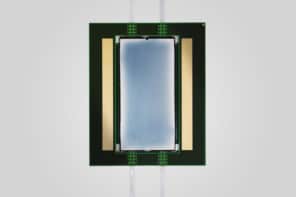
Almost six years ago, Leo Kouwenhoven’s research team glimpsed a particle that is both matter and antimatter, for the first time since it was theoretically predicted in 1937 by Ettore Majorana. Now, thanks to their improved fabrication process, the same collaboration of groups from Delft University of Technology and Eindhoven University of Technology has confirmed their measurements did find the elusive Majorana particle. Their work, published in Nature Nanotechnology, brings Majoranas one step closer to use as robust quantum bits in powerful quantum computers.
The Majoranas with potential for quantum computing are not stand-alone particles, but “quasiparticles” – emerging in special combinations of materials. The Netherlands-based collaboration specializes in combining a semiconductor nanowire with a superconducting film, by partially wrapping a nanowire section with the film to induce an exotic form of superconductivity.
By making an atomically smooth nanowire-superconductor interface, the team reduced electron collisions down to the ‘ballistic’ regime, where electrons can travel the length of the nanowire without scattering. This ideal transport regime maximizes the connection between, and signal of, the Majorana particles at the two nanowire ends. It cleared the way for scientists to exclude alternative explanations for the Majorana signal, which, in their previous nanowire experiment, could have come from the unwanted scattering or disorder.
The signal of an elusive particle
The Majorana particles’ signal lies at the very centre of an energy range usually forbidden for quasiparticles in a superconductor, at the so-called “zero energy”. The zero-energy Majorana can only emerge when the researchers switch on exotic superconductivity in the nanowire, producing the Majorana signature: a “zero-bias peak”. This is exactly the signal the team measured. They then checked the peak occurred at magnetic field strengths and directions predicted by theory, and that it had the characteristic robustness that makes Majoranas so attractive for storing quantum information. Finally, they had collected enough evidence to confirm their glimpsed Majorana a reality, as paper co-author Jouri Bommer concluded: “With our improved Majorana measurements, we can be absolutely certain that the zero-bias peak means that we have actually found Majoranas.”
It looks like a Majorana particle… now can it act like one?
Eighty years on from their theoretical prediction, the dialogue between experiment and theory is what makes Majorana particles an exciting quest for physicists. Even before publication, pioneering theoreticians in the USA were already supporting these new experimental discoveries.
The ultimate test, however, will be when Majoranas are not just found, but used as protected quantum information states. Harnessing and manipulating these exotic particles will require more complex devices, but the Eindhoven Technical University collaborators are already creating nanowire networks that might be the key. The reward would be a quantum leap on the roadmap towards topological quantum computing.



